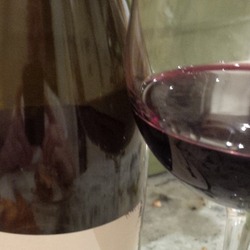Excellence
Quilceda Creek
Columbia Valley Cabernet Sauvignon 2004

Mas des Bressades
Cuvée Excellence Costières-de-Nîmes Syrah 2015
Spice from the rousanne evident in this delicious bargain southern white. — 8 years ago
Stoney Ridge
Excellence Niagara Peninsula Chardonnay 2011
Very well aged! Complex taste. — 9 years ago
Producteurs Plaimont
Terres d'Artagnan Sélection Excellence Côtes de Gascogne White Blend 2015
Лукьяновка рекомендует — 9 years ago
Louis Perdrier
Brut Excellence Sparkling Blend
This is truly exceptional, semi-dry, delight bursts of a Fuji Apple, a very light hint of oak, long smooth finish, lots of bubbles — 10 years ago
Gosset
Excellence Brut Champagne Blend
Lätt, torr men lite fruktig och lagom låg syra — 10 years ago
Cave des Producteurs de Vouvray
Brut Excellence Vouvray
Perfectly dry and wet; classic Chenin; delightful as an aperitif. — 10 years ago
Gosset
Brut Champagne Blend
Gosset is a fine champagne house that I have only recently got exposed to, I can regret what I missed or try to catch up :-) as you can see I went for the more pleasurable option. The excellence is indeed excellent, lovely light gold color, a fresh stream of small sexy bubbles, appealing nose full of lime, grapefruit, apple, yeasts and healthy dose of minerality, on the palate smooth and fresh, silky yet tingling, fresh finish. My score 90. Drink when you feel like having a fresh pleasure. — 10 years ago
Feudo di Santa Croce
Primitivo di Manduria 2010
This is a Signor Primitivo. Times when Puglia was a land of grapes for cutting are way passed, and this is the clear proof of excellence. Big and smooth, with the red fruit scentors surpassed by the wood, coffee and leather with a hint of vanilla — 11 years ago
Copper Moon
Moonlight Harvest Shiraz
By far a favourite, never fails to add the extra hint of excellence to the day. — 11 years ago
Philip Togni Vineyard
Napa Valley Cabernet Sauvignon 2014
Stoic and utterly profound, this wine is an infant, but demonstrates incredible promise. Togni is a master, having crafted the 1969 Chappellet - likely the best wine I’ve ever tasted. His daughter Lisa holds the reigns now, and continues her family label’s string of excellence. “Old School” — 8 years ago
Koehler-Ruprecht
Kallstadter Kabinett trocken Riesling 2009
Diesel and honeydew nose. Clean crisp apple mid weight excellence. 30 minutes later oxidized notes appear, matching the color. Find it if you can! — 8 years ago
Château Du Ballandreau
Cuvée Excellence Bordeaux Supérieur 2014
Great Bordeaux. Tart & smoky with some body — 8 years ago
Moulin des Verny
Cuvée Excellence Crémant de Bourgogne Pinot Noir Chardonnay
Dry and crisp, light and clean. Tart apple. Very easy to drink. — 9 years ago
Château Lafite Rothschild
Pauillac Red Bordeaux Blend 1986
Its hard to find words for this beauty. A nose of cedar and tobacco leaf, graphite. Lighter bodied than expected but lithe, feline, with a core of dark berry and a tapestry of perfectly concentrated blackberry, cherry and light floral elements. It just got better with every sip, passing through any reference I have for Bordeaux excellence. — 9 years ago
Erba Mountainside Vineyards
Napa Valley Cabernet Sauvignon 2007
This shows the excellence of a vintage with all the power of Napa's fruit. — 10 years ago
Weingut Kadlec
Lyss Excellence Red Blend
Excellent red cuvee also gold awarded wine from Burgenland Austria — 10 years ago
Rémy Martin
XO Excellence Cognac Ugni Blanc
A pleasant way to end an evening. — 11 years ago
Nicolis Angelo e figli
Ambrosan Amarone della Valpolicella Classico 2006
Excellence in winemaking! — 12 years ago
Château Cos d'Estournel
Les Pagodes de Cos Saint-Estéphe Red Bordeaux Blend 2005
Is there anything better than Ribeye & Claret? From my perspective, no. This is the second wine from one of more prestigious Chateaus in St. Estephe. Bordeaux rule number 2, buy the hell out of good producers second wines in very good vintages, like 2005. You’ll get great wines at more affordable prices. Providing, you exercise patience; which is rule number 1. Decanted for 3 plus hours. On the nose, ripe; blackberries, dark cherries, black raspberries, baked strawberries, black plum & cherries pull up the rear. Incense, herbaceous character, anise, scorched dark earth, burnt ambers, anise, baking spices dominated by vanilla, black tea, black cherry cola, loamy dry soils, dry & fresh red florals with violets for days. It’s in a great phase with many years ahead. The body is full and round. The texture has you wanting more. It’s velvety and ripe. Tannins soft and powdery, around 65-70 resolved. The fruits are ripe & ruby...showing the excellence of the 05 vintage. Blackberries, dark cherries, black raspberries, baked strawberries, black plum & cherries pull up the rear. Incense, herbaceous character, anise, scorched dark earth, dry stones, leather, cigar with ash, burnt ambers, anise, baking spices dominated by vanilla, black tea, black cherry cola, loamy dry soils, dry & fresh red florals with violets for days. The acidity is dead on. The length, structure, length & balance is harmonizing like America on the album, “ Horse with No Name.” The long finish is; ruby, rich, elegant, round, beautiful and lasts a minute plus. Beautiful wine. 9.4 with the steak. 9.2 on its own. Photos of; Chateau Cos d’ Estournel, hosting/tasting area, private wine stock and barrel cellar. Producer notes and history...Chateau Cos d’Estournel has a long history in the appellation of St. Estephe. Louis Gaspard d’Estournel, gave his name to the estate after founding it in 1811. It only took a few years before Chateau Cos d’Estournel became famous with wine lovers and royalty all over the world. In the early days, the wines of Cos d’Estournel were not sold through the Negociant system. The owner preferred selling his wine directly to his customers. In fact, Chateau Cos d’Estournel was exported to numerous countries across the globe, with a large portion of the production being sold to India. It was that connection to India that inspired much of the unique, east Indian design we see at Cos d’Estournel today. Chateau Cos d’Estournel was one of the first Chateaus to bottle, label and sell their own wine. This practice continued until the death of Louis Gaspard d’Estournel in 1852. After his death, the estate was purchased by an owner that sold their wines on the Place de Bordeaux, using the negociant system. If the Chateau had not been selling their wines through the negociant system, it would never have been included in the 1855 Classification! Chateau Cos d’Estournel was sold to the Charmolue family, the owners of the neighboring Chateau Montrose. They continued to own the estate until 1917, when it was bought by Fernand Ginestet. The purchase was the next major step in the development of Cos d’Estournel. The next era in the development of Chateau Cos d’Estournel took place in 2000, when Chateau Cos d’Estournel was bought by Michel Reybier, who made his fortune in the food industry. Michel Reybier hired the son of Bruno Prats, Jean-Guillaume Prats to manage Cos d’Estournel. Things improved with the efforts of Jean-Guillaume Prats who helped design the most modern wine making facilities in the entire Bordeaux wine making appellation at the time. A complete renovation of Cos d’Estournel took place in the winemaking facilities and cellars. The wine making facilities are completely modern, using 100% gravity. On October 15, 2012, Jean Guillaume Prats announced he was leaving Chateau Cos d’Estournel to join LVMH. Jean Guillaume Prats was replaced by Aymeric de Gironde. Following the departure of Aymeric de Gironde in 2017, the owner, Michel Reybier took over managing the estate. In 2018, the estate released COS100, produced from their oldest Merlot vines that were 100 years of age. It was limited in production to a 100 Jeroboams, (3 litres) and 10 Balthazars (12 litres) and a few other sizes were produced from only 2 barrels of wine. The proceeds from COS100 go to the charity, Elephant Family, that is devoted to protecting and nurturing Asian elephants in their own, natural habitat. Cos d’Estournel’s new cellar is a joint reflection by the technical team, the architect Jean-Michel Wilmotte and Jean Guillaume Prats. It’s a marvel blend of simplicity and modern technology. Cos d’Estournel is unique to Bordeaux and the rest of world. What makes this special is that the cellars of Cos d’Estournel are entirely operated by gravity. There are no pumps of any kind to force the wine. The purpose is to allow a gentleness to the wine and improve its purity allowing for expression of their special terroir. It set a new benchmark for cellars not only in the Left Bank, but in all of Bordeaux. The new cellars at Chateau Cos d’Estournel include 72 isothermal cone shaped stainless steel vats. The vats are specifically designed for thermal inertia. The 72 vats have a wide range of capacities to correspond with the needs of each parcel of vines. The vats range in size from as small as 19 hectoliters all the way up to 115 hectolitres. 12 of the smaller vats that are designed to handle between 19 and 60 hectoliters that have two levels in each vat. In other words, this offers the technical equivalent of 24 separate vats. Each of the vats are double lined, which allows for more exact and temperature control. None of the vats use interior heat coils. Perhaps the most inventive part of the cellars is the four 100 hectoliter lift tanks or wine elevators that replace the pumps used in the traditional pumping over and racking off processes, which introduce air and often destabilize the marc. From the moment the grapes arrive, everything travels by the flow of gravity. Jean Guillaume Prats called this process a pumpless, pump over. What takes place is, the wine is released from the main vat where the skins remain. By gravity, the juice is then moved into smaller vats which are on wheels. These small vats are sent to the glass elevators where they are moved up one floor and returned back into the vat by gravity to cover the skins. At this point, the process is still unique to Chateau Cos d’Estournel. The wine production of Cos d’Estournel is labor intensive starting the moment the grapes enter their new facility. The berries travel through a tunnel that instantly lowers the temperature of the fruit to 3-5 degrees Celsius. This sudden chilling stops the loss of juice while also slowing oxidation. Next, the grapes are cold macerated at 7-9 degrees Celsius for about a week. Pump overs are done by gravity recycling. The juice from the top of the vat moves to the bottom of the vat entirely by gravity. The fermentation takes place at low temperatures to avoid over extraction or harsh tannins. The 91 hectare vineyard of Chateau Cos d’Estournel is planted to 65% Cabernet Sauvignon, 33% Merlot, 1% Cabernet Franc and 1% Petit Verdot. The vineyard is located close to the border of Pauillac and Saint Estephe at the southern tip of the Saint Estephe appellation. The vineyard has cultivated 84 hectares of vines. Even though the vineyard has been expanded over the years, the grape varietals planted here have remained consistent. The vineyard, located on the hill of Cos, has gentle elevations of up to 20 meters. On average, the vines are 35 years of age. However, the estate has very old Merlot vines as well, which date back more than 100 years. Part of the terroir is situated on the hill of Cos, which is at a high elevation for the Medoc at 20 meters. Cos d’Estournel is translated from old Gascon speech; which means the hill of pebbles. It describes the terroir along with clay, gravel, sand and limestone soil. However, there is a unique aspect to the soil at Cos d’Estournel, as you find more gravel and less clay here than you do at other neighboring vineyards. Because the fruit is grown close to the Atlantic ocean in a cool climate, Cos d’Estournel is often among the last of the properties in the Medoc to harvest. The vineyard is managed by teams and each team member is given 45,000 vines to look after. The vineyard, which is almost one large block, can be further divided into 72 separate parcels. — 8 years ago

Sharffenberger
Brut Excellence Sparkling Blend
Always a good value at a decent price point — 10 years ago
De Chanceny
Brut Excellence Tête de Cuvée Vouvray Chenin Blanc 2012
Great Sparkling wine. Nice acidity, refreshing and great balance. — 11 years ago
Vang Dalat
Excellence Cabernet Sauvignon/Merlot
Really quite good (balanced, fruit forward with nice tannins) compared to their non-Excellence wine. Vietnam should be proud! — 11 years ago
Château les Ollieux
Excellence Corbières Carignane Blend
Mild and soft touch at beginning and taste rich. Good and middle body. Bought at Vinos Yamazaki. — 11 years ago
Château Cos d'Estournel
Saint-Estèphe Red Bordeaux Blend 2002
Proof positive that a star producer can deliver in variable vintages. This is an easy contender for the most satisfying Bordeaux experience I've had. Stress eliminator par excellence. — 12 years ago
























Mark Flesher
This is definitely a little bit of a departure from other Cabernets that were enjoyed tonight. Still extremely elegant. Enjoyed En Magnum. This is 15 years of Columbia Valley excellence. The news on this wine was clove, truffle, black cherry. The entry had a little bit of a bleu cheese, green grapestem, black cherry, fig. The middle is where this one started to settle more to a red and black fruit profile.... but mostly favored the black fruit side of things. Finishes with a little bit of black pepper, with softened tannins that carried it through to the finish. If in 750, I would say it is definitely time to start popping and enjoying these. If it is in Magnum, this is actually a rather enjoyable wine and I feel it will likely develop a bit more. — 7 years ago